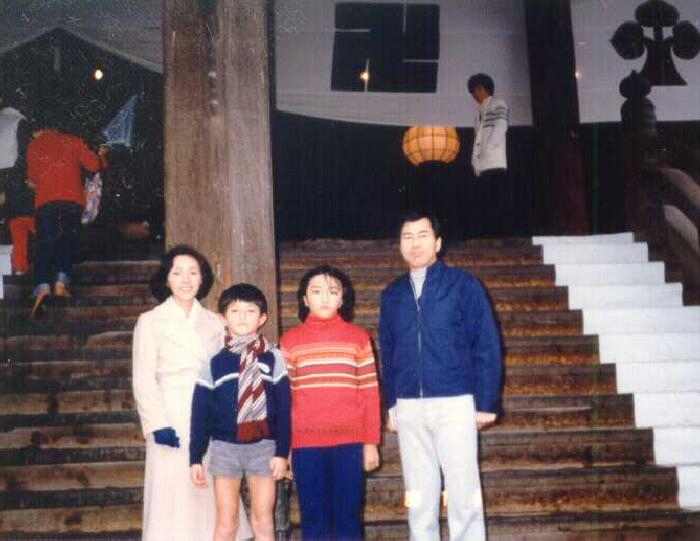
Japanese Middle Class Family (probably 1980s)

Figure 1.-- Here we see a middle class family on a outing. The image is undated, but we would guess it was the 1980s. There are two children, a boy and a girl--common in urban families by the 1980s. It appears to be a cold day. Every one but the boy is dressed warmly.
|
|
Here we see a middle class family on an outing. The image is undated, but we would guess it was the 1980s. There are two children, a boy and a girl--common in urban families by the 1980s. It appears to be a cold day. Every one but the boy is dressed warmly. Note that mother wears a long coat and gloves. His sister wears long pants. The boy wears a sweater and scarve with short pants and kneesocks. This may be how he dressed for school. I am not sure where they are. It looks like a lobby to a theater or shrine. Perhaps our Japanese readers can tell us more about the scene.
The Family
Here we see a middle class family. There are two children, a boy and a girl--common in urban families by the 1980s.
Scene
The family is on a outing. I am not sure where they are. It looks like a lobby to a theater or shrine. A Japanese reader tells us, "The family is on the steps of a Shinto shrine or possibly a Buddhist temple--the swastika would indicate that. Most likely since it is the whole family and it is winter it is a new year's visit to a shrine. Families typically visit shrines in the first few days of the New Year. The corduroy short shorts, sweater, knee socks and scarf worn by the boy were completely unexceptionally winter wear for Japanese boys of 12 and younger during the 1970s and 80s."
Chronology
The image is undated, but we would guess it was the 1980s. A Japanese reader tells us, "my guess is you are right about the date, although it could be as early as the late-60s (both the woman's hairdo and the way the young man at the top of the stairs is wearing his hair suggests the late 70s). It could conceivably be early 90s, as non-uniformed school short-shorts didn't disappear completely until the middle of the decade.
Clothing
It appears to be a cold day. Every one but the boy is dressed warmly. Note that mother wears a long coat and gloves. His sister wears long pants. The boy wears a sweater and scarve with short pants and kneesocks. This may be how he dressed for school. A Japanese reader writes, "I must disagree with you here. It is not really correct to say that the boy is the only one "not dressed warmly". By the standards of the time, he WAS dressed warmly -- sweater and scarf. Far less heat is lost through bare knees and bare legs than through a bare head. A bare-headed American boy in long pants is less warmly dressed than a Japanese (or Scottish) boy in shorts, knee socks, and a wool cap. Japanese boys simply wore shorts year round and to say that a Japanese boy in shorts was "not warmly dressed" is like saying an American businessman in an overcoat is "not warmly dressed" because he isn't wearing a hat. American men don't wear hats and Japanese boys didn't wear long pants. Indeed I wore short pants with keesocks to primary school and I don't recall being especially cold in the winter."
HBC

Navigate the Boys' Historical Clothing Web Site:
[Introduction]
[Activities]
[Biographies]
[Chronology]
[Clothing styles]
[Countries]
[Topics]
[Bibliographies]
[Contributions]
[FAQs]
[Glossaries]
[Satellite sites]
[Tools]
[Boys' Clothing Home]
Navigate the Boys' Historical Clothing Japanese pages:
[Return to the Main Japanese family page]
[Return to the Main Japanese country page]
[Choirs]
[Department store catalogs]
[Monarchy]
[Movies]
[Music recitals]
[School uniforms]
[Scouts]
Created: 5:15 AM 7/2/2004
Last updated: 5:15 AM 7/2/2004



